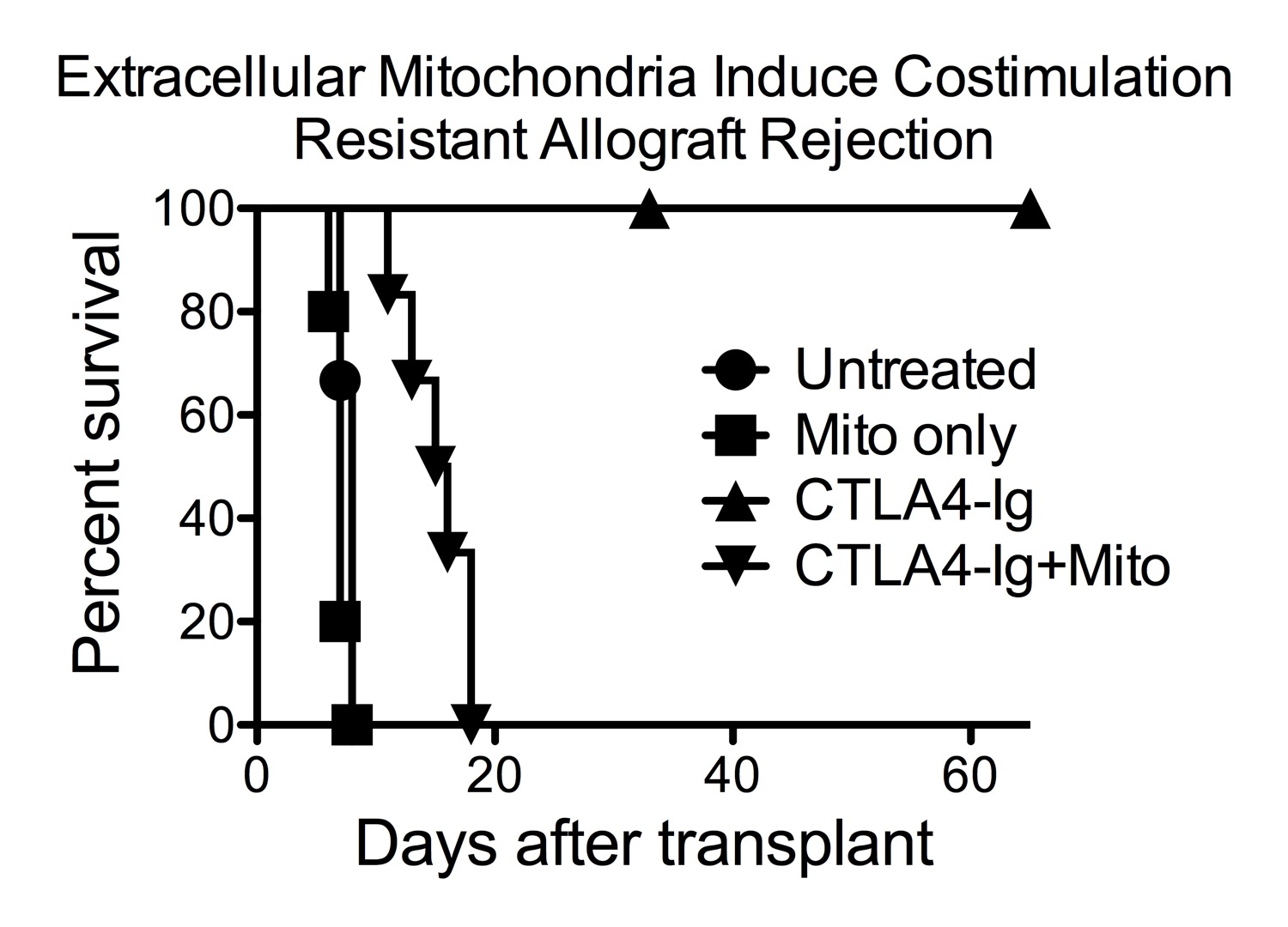Extracellular Mitochondria Cause B7 Costimulation Blockade Resistant Allograft Rejection in Mice.
1Surgery, Duke University, Durham, NC
2Immunology, Duke University, Durham, NC
Meeting: 2017 American Transplant Congress
Abstract number: 449
Keywords: Allorecognition, Autoimmunity, Co-stimulation, Immunogenicity
Session Information
Session Name: Concurrent Session: New Pathways in Allograft Rejection
Session Type: Concurrent Session
Date: Tuesday, May 2, 2017
Session Time: 2:30pm-4:00pm
 Presentation Time: 3:06pm-3:18pm
Presentation Time: 3:06pm-3:18pm
Location: E352
Introduction: Mitochondria released in the setting of tissue injury and cell death are a source of damage-associated molecular patterns that activate innate immune responses. We sought to determine the impact of extracellular mitochondria on allograft endothelial cell (EC) activation and vascularized allograft rejection in the setting of co-stimulation blockade.
Methods: MHC-mismatched BALB/c to B6 cardiac allograft mean survival time (MST) was determined in the presence or absence of costimulation blockade with CTLA4-Ig along with intravenous treatment with purified murine mitochondria. Following graft rejection, T cells were FACS analyzed for CD28 expression and effector memory (TEM, CD44+CCR7neg) phenotype. Post-transplant allograft EC CD40 expression was assessed by immunohistochemistry.
Results: In the absence of costimulation blockade, post-transplant intravenous mitochondria treatment (Mito-tx) resulted in similar allograft rejection rates as untreated controls (Mito-tx MST 6.8±0.8 days; n=5, vs control MST 7.6±0.5 days; n=5), but increased CD4+TEM frequency (Mito-tx 51±8% vs control 34±14%, p=0.034), and CD8+TEM frequency (Mito-tx 87±1.4% vs control 66±13%, p=0.005). Costimulation blockade with CTLA4-Ig dramatically increased allograft survival (>65 days, n=5) and reduced TEM frequencies (CD4+ 14±18%, CD8+ 20±4%). However, co-treatment with CTLA4-Ig and mitochondria resulted in rapid rates of allograft rejection (MST 14.9±2.6 days, n=6) and correspondingly increased TEM frequencies (CD4+ 30±7%, CD8+ 35±5%). Mito-tx had no effect on TEM cell expression of CD28, but induced CD40 expression on allograft vascular ECs compared to untreated mice.
Summary: Extracellular mitochondria cause costimulation resistant allograft rejection in mice by activating graft EC and increasing CD4+ and CD8+ TEM responses. Tissue injury resulting in mitochondrial release may predispose allografts to rejection mediated by effector memory T cells.
CITATION INFORMATION: Brennan T, Lin L, Song M, Feng F, Li Q.-J, Kirk A, Xu H. Extracellular Mitochondria Cause B7 Costimulation Blockade Resistant Allograft Rejection in Mice. Am J Transplant. 2017;17 (suppl 3).
To cite this abstract in AMA style:
Brennan T, Lin L, Song M, Feng F, Li Q-J, Kirk A, Xu H. Extracellular Mitochondria Cause B7 Costimulation Blockade Resistant Allograft Rejection in Mice. [abstract]. Am J Transplant. 2017; 17 (suppl 3). https://atcmeetingabstracts.com/abstract/extracellular-mitochondria-cause-b7-costimulation-blockade-resistant-allograft-rejection-in-mice/. Accessed December 23, 2025.« Back to 2017 American Transplant Congress
